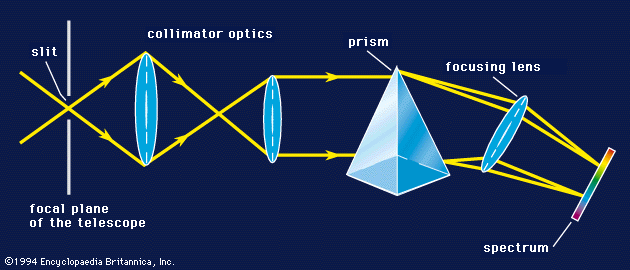Spectrographs
Spectrographs:
- Take light from a source (into the telescope)
- Pass it through a slit
- Collimate it (force all beams to pass in a single direction)
- Push it through a dispersing element (like a prism to separate it)
- Pass it through a camera (to reform it)
- Send to the observer

Diffraction gratings are often used as the dispersing element (in place of a prism) because prisms can get really expensive.
Sometimes, folks will sandwich prisms, gratings and another prism, to form a GRISM - this is the case at APO's KOSMOS.
Taking spectra
We don't need great seeing for spectra - so they can be useful to take on nights with low seeing. However, spectra require long exposure times for reasonable S/N ratio in every pixel.
Guiding can be done by a "slit view" camera (i.e. spectrograph in center, normal otherwise) or via an off-axis guider (like at MRO).
Resolving power
For spectra, resolution is defined as
which can be for high-resolution spectra. is generally limited by slit-width.
Resolution can also be related to Doppler shift via
Wavelength calibration
- Find a lamp spectrum (i.e. using a dome light)
- Extract an ID spectrum using the same aperture and trace
- Using known lines and their pixel values, determine a dispersion solution
- Apply it to the 1-D spectrum